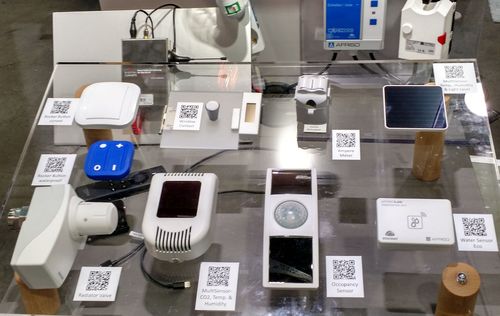IoT & Embedded Technology Blog
CES 2016, Part 3: Wireless IoT Technologies Proliferate
Another of the trends that stood out most to VDC at this year’s CES was the ubiquity of wireless technologies. It was rare that any connected product on display did not include wireless, the most prevalent types being Bluetooth Smart, Wi-Fi, and ZigBee.
Bluetooth Smart, also known as Bluetooth Low Energy (LE), is ideal for many wearable devices that will communicate with the user’s nearby smartphone. Wi-Fi is best for IoT devices in a home or small business environment, leveraging existing routers and networking for other PC and Internet communications. ZigBee is a short range mesh network with a communications protocol adopted by numerous device makers, primarily in the smart home market. But none of these technologies is suited to longer range communications required in many industrial, commercial, and government IoT applications. Fortunately, there is no shortage of alternatives that are well-suited, the two most widely known being the Low-Power Wide-Area Networking (LPWAN) technologies Sigfox and LoRa.
Both Sigfox and LoRa send low bit-rate data (kilobits per second) over long distances (miles) from sensing devices to antennas and base stations which are often co-located with cell phone infrastructure. Sigfox has established nationwide public networks in its native France, as well as in Spain and Netherlands, with partial coverage in Denmark, Germany, Italy, UK, US, and other countries. Endpoint devices can run for years on battery power. Sigfox owns its infrastructure in France, but relies on partners elsewhere. The biggest knock against Sigfox has been the technology’s limited ability for bi-directional communications, so it is not suitable for sending over-the-air (OTA) firmware updates.
LoRa is similar to Sigfox, with the most notable difference being better bi-directional support, but it is based on patented technology controlled by semiconductor supplier Semtech. Both Sigfox and LoRa use unlicensed sub-gigahertz spectrum in the Industrial, Scientific, and Medical (ISM) bands with frequencies that vary by region (Europe vs. US vs. Asia).
(The finer points of these networks are beyond the scope of this blog post, but VDC Research will delve further into IoT wireless technologies in a forthcoming market research report.)
Here are some of the other IoT wireless technologies that we investigated at CES.
LTE-M – as the naming implies, LTE-M uses Long Term Evolution (LTE) cellular networks, but intended for M2M applications with lower cost chipsets, longer battery life, and reduced data throughput. Two “categories” of LTE-M using narrowband communications have been defined, Cat M1 (maximum throughput of 1 megabits per second for combined downlink and uplink), and Cat M2 (maximum throughput of 500 kilobits per second downlink and 40 kilobits per second uplink). These are in addition to the existing wideband LTE Cat 1 standard (up to 10 megabits per second downlink, 5 mbps uplink), as well as a previously specified but never brought to market Cat 0 (up to 1 megabits per second bi-directional). Service costs for Cat M1 and Cat M2 are likely to be lower than conventional LTE cellular data services, but still higher than for LPWAN and other options.
Ingenu (formerly called On-Ramp) – Another LPWAN, but running in the 2.4GHz frequency band worldwide, and therefore not in need of separate ISM frequencies for each major geographical region. The Ingenu company owns its own network infrastructure.
GreenWaves – Not a specific network, but a radio communications technology that can be applied to other LPWANs to reduce power consumption and increase efficiency of bandwidth use. It reduces the peak power required to distinguish signal from noise, and is suitable up to 1 mbps.
DecaWave – Small, battery-powered radio chips that can be embedded in devices to provide location information precise to within centimeters, as well as data throughput up to 6 mpbs. Location is measured via beacons, either indoors or outdoors, with range up to 300 meters (direct line-of-sight). The DecaWave company says it’s accurate enough to measure speed of moving objects, up to several hundred kilometers per hour. It's based on patented technology that DecaWave plans to license to other chipmakers.
And lastly,
enOcean – Energy-harvesting technology to communicate low data volumes (up to 32 bytes at a time) up to 1,000 feet with no battery or other external power source. Small amounts of electrical current are generated by the devices, using one of four methods:
- Mechanical – the act of physical movement, such as pressing a button
- Thermal – temperature differences between dissimilar semiconductors (Seebeck Effect)
- Magnetic Field – energy radiated by electricity passing through other wires in close proximity
- Solar – photo-voltaic cells which charge a super-capacitor
By completely eliminating batteries or wired power sources, enOcean has the potential to ease the burden of installing and maintaining IoT connectivity for many types of sensors and actuators. enOcean licenses its technologies to partners (the enOcean Alliance) who design and manufacture products such as those shown below.

enOcean wireless energy harvesting devices on display at CES, including rocker switches, window sensor, ampere meter, temperature/humidity/light sensor, radiator water valve, CO2/temperature/humidity sensor, occupancy sensor, and water sensor
None of the many wireless technologies shown at CES suits all applications, and they undoubtedly will co-exist. Nevertheless, we expect more to pop up in the coming year. As they say in the radio business, stay tuned.
View the 2017 IoT & Embedded Technology Research Outline to learn more.